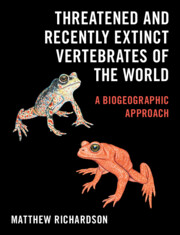Book contents
- Threatened and Recently Extinct Vertebrates of the World
- Threatened and Recently Extinct Vertebrates of the World
- Copyright page
- Dedication
- Contents
- Foreword
- Preface
- Acknowledgements
- Chapter 1 The Arctic Realm
- Chapter 2 The Palearctic Realm
- Chapter 3 The Afrotropical Realm
- Chapter 4 The Madagascan Realm
- Chapter 5 The Indo-Malaysian Realm
- Chapter 6 The Papua-Melanesian Realm
- Chapter 7 The Australian Realm
- Chapter 8 The Polynesian Realm
- Chapter 9 The Nearctic Realm
- Chapter 10 The Caribbean Realm
- Chapter 11 The Neotropical Realm
- Chapter 12 The Patagonian Realm
- Chapter 13 The Antarctic Realm
- Chapter 14 The Oceanic Realm
- Chapter 15 Global Balance
- Bibliography
- Index
Chapter 5 - The Indo-Malaysian Realm
Published online by Cambridge University Press: 24 February 2023
- Threatened and Recently Extinct Vertebrates of the World
- Threatened and Recently Extinct Vertebrates of the World
- Copyright page
- Dedication
- Contents
- Foreword
- Preface
- Acknowledgements
- Chapter 1 The Arctic Realm
- Chapter 2 The Palearctic Realm
- Chapter 3 The Afrotropical Realm
- Chapter 4 The Madagascan Realm
- Chapter 5 The Indo-Malaysian Realm
- Chapter 6 The Papua-Melanesian Realm
- Chapter 7 The Australian Realm
- Chapter 8 The Polynesian Realm
- Chapter 9 The Nearctic Realm
- Chapter 10 The Caribbean Realm
- Chapter 11 The Neotropical Realm
- Chapter 12 The Patagonian Realm
- Chapter 13 The Antarctic Realm
- Chapter 14 The Oceanic Realm
- Chapter 15 Global Balance
- Bibliography
- Index
Summary
The Indo-Malaysian Zoogeographic Realm is comprised primarily of the tropical parts of South and South East Asia although extending some degrees north in places into the subtropical zone, particularly in northern India. It includes most of the Indian subcontinent south of the Himalayas together with most of Indochina, the Malay Peninsula, and the islands of the Sunda Archipelago. Biogeographically it is divided among the Oriental, Sundaic, and Wallacean zoogeographic regions. The majority of it was originally covered by both tropical moist and dry forests, with a few scattered areas of savanna and desert. Its evolution was greatly affected by ice-age sea-level changes. At the height of the last glacial age, the oceans were hundreds of metres lower than at the present time. Lands like Indonesia and the Philippines, and perhaps New Guinea and Australia as well, were not as widely separated as today. At least Indonesia was certainly connected with the mainland and with the Philippines as late as about 18,000 years ago. These climatic oscillations, with long warm, interglacial stages between the cold periods, as well as the rise and fall of the oceans, had a tremendous impact on animal distribution patterns and migrations, and this is still going on. When sea levels dropped during the Pleistocene Bali was connected to both Java and Sumatra as well as to the Asian mainland, but the deep water of the Lombok Strait continued to keep the rest of the Sunda Islands isolated. The Lombok Strait lies to the immediate west of the island, marking the passage of the biogeographical division between the prolific fauna of the Indomalayan ecozone and the distinctly different, but similarly prolific, fauna of Australasia – this distinction is known as the ‘Wallace Line’ (or ‘Wallace’s Line’) and is named after Alfred Russel Wallace, the first to comment on the division between the two regions as well as on the abrupt boundary between them.
- Type
- Chapter
- Information
- Threatened and Recently Extinct Vertebrates of the WorldA Biogeographic Approach, pp. 203 - 293Publisher: Cambridge University PressPrint publication year: 2023



